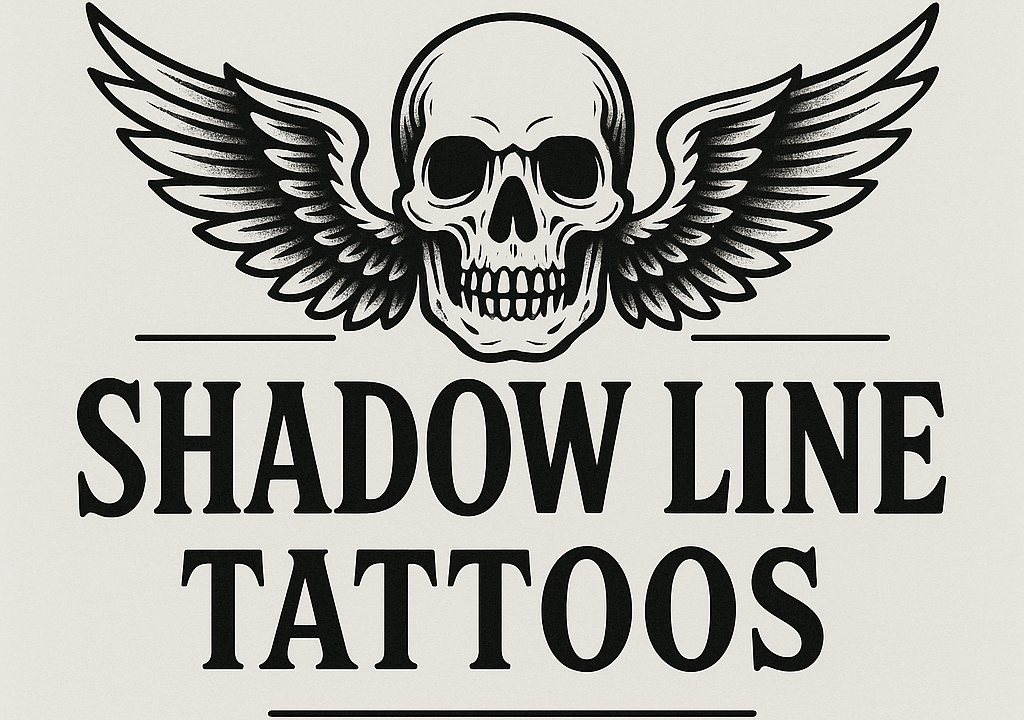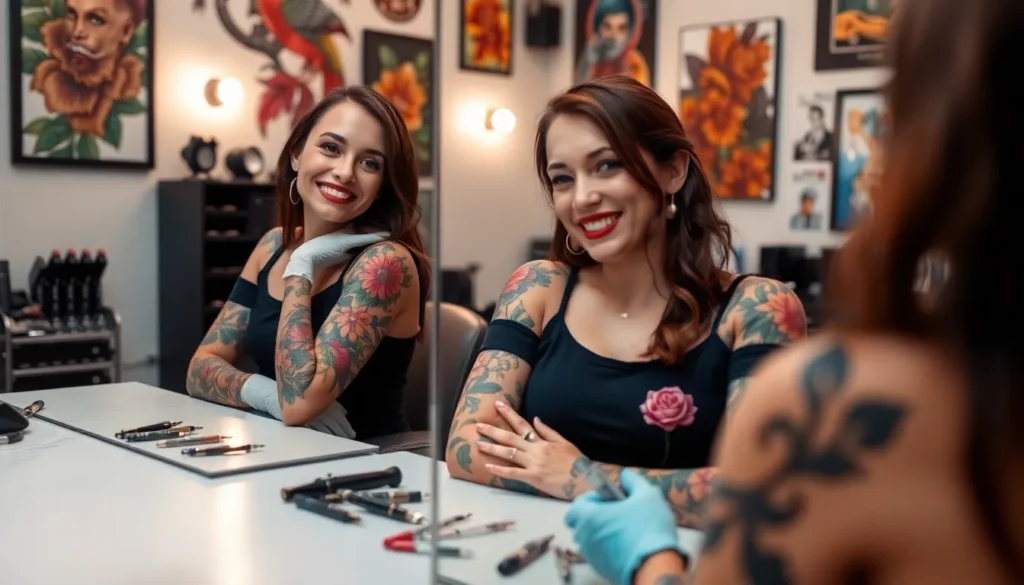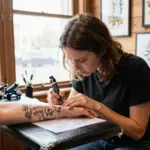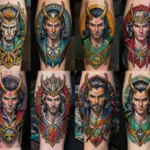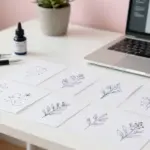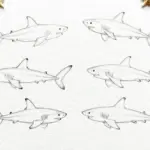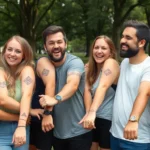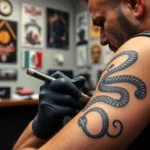We’ve all been there – staring at a tattoo that no longer represents who we are or simply didn’t turn out as expected. Whether it’s an ex’s name, a poorly executed design, or artwork that’s faded beyond recognition, unwanted tattoos don’t have to be permanent reminders of past decisions.
Cover-up tattoos offer an incredible opportunity to transform old ink into stunning new artwork that you’ll actually love showing off. With the right design approach and skilled artist, even the darkest or most complex tattoos can be cleverly concealed beneath beautiful new pieces.
We’re about to explore creative cover-up answers that’ll help you reclaim your skin with confidence. From bold florals that mask unwanted text to intricate geometric patterns that work around existing lines, there’s a cover-up strategy for every situation and style preference.
Understanding the Basics of Cover Up Tattoos
Cover up tattoos require exact technical knowledge to transform unwanted ink into stunning new artwork. We’ll explore the fundamental principles that make these transformations successful.
What Makes a Good Cover Up Design
Bold imagery works best for covering existing tattoos since it can effectively mask the underlying ink. Designs with solid black areas, dense shading, and high contrast elements provide the coverage strength needed to hide previous artwork completely.
Organic shapes like flowers, animals, and nature scenes excel at cover up work because they naturally incorporate irregular edges and flowing lines. These designs can wrap around and integrate existing tattoo elements rather than fighting against them.
Strategic placement of dark elements allows artists to position the heaviest coverage over the most problematic areas of the original tattoo. We recommend choosing designs where natural shadows and deep colors fall exactly where you need maximum coverage.
Sizing Considerations for Effective Coverage
Size requirements typically increase by 2-3 times the original tattoo dimensions to achieve complete coverage. Smaller cover ups often fail because they don’t provide enough surface area to fully mask the underlying artwork.
Extending beyond original borders ensures no traces of the old tattoo peek through around the edges. Most successful cover ups extend at least one inch past the original tattoo’s perimeter on all sides.
Placement flexibility becomes crucial when working with larger cover up designs since the new artwork needs adequate skin space. We often recommend considering adjacent body areas that can accommodate the expanded design naturally.
Color Theory in Cover Up Tattoos
Darker colors always cover lighter ones in tattoo work, making black, deep blues, and rich purples the most effective covering agents. Light colors like yellow, pink, and white cannot successfully cover any existing dark ink.
Complementary color combinations help neutralize unwanted hues from the original tattoo underneath. Green ink covers red effectively, while purple can neutralize yellow tones that may show through.
Saturation levels determine coverage success since highly saturated, dense colors provide better opacity than pale or diluted inks. We recommend choosing designs that incorporate multiple layers of rich, opaque colors for the most reliable results.
Choosing the Right Artist for Your Cover Up
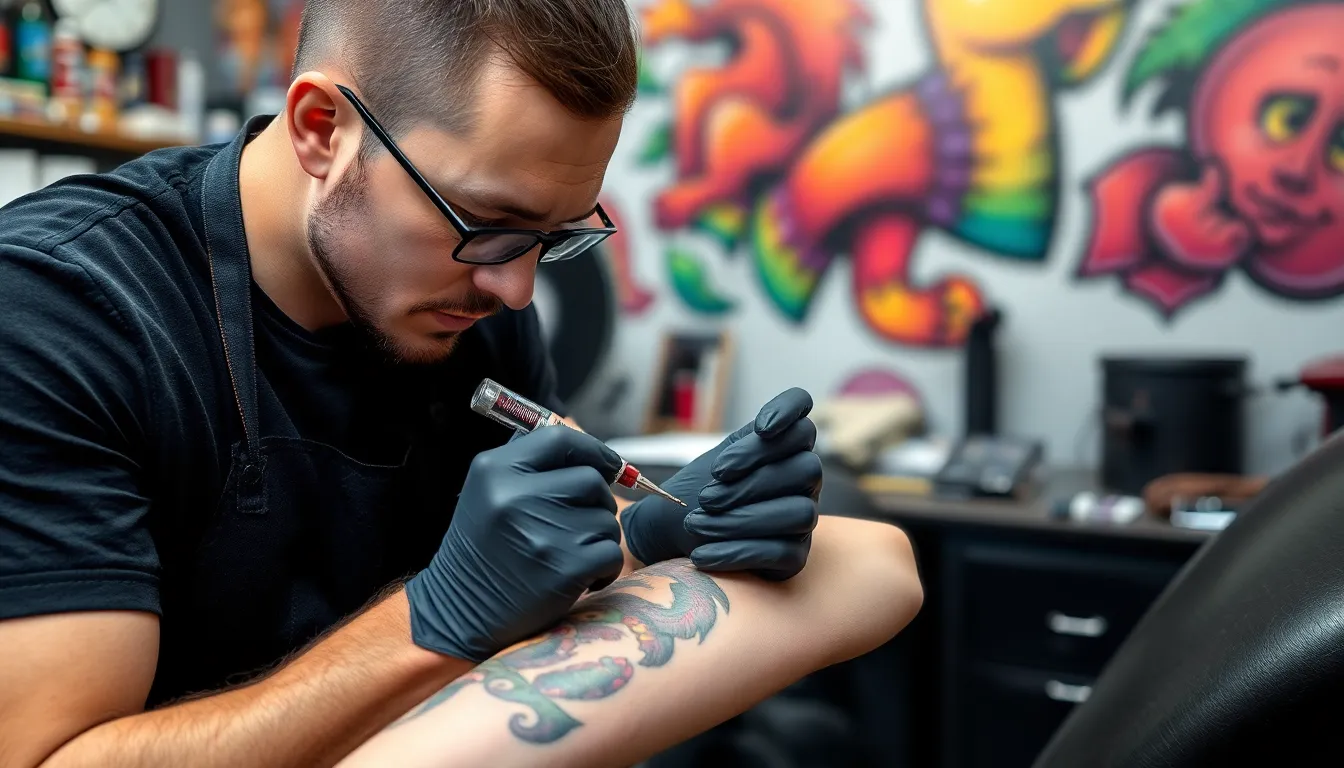
Finding the perfect artist makes all the difference between a stunning transformation and a disappointing result. We can’t stress enough how crucial this decision becomes when you’re investing in covering up existing ink.
Researching Portfolio and Experience
Portfolio diversity should be your first checkpoint when evaluating potential artists. We recommend looking specifically for before and after photos of cover up work rather than just general tattoo samples. Artists who showcase various cover up techniques demonstrate their ability to handle different challenges and skin tones.
Client testimonials provide real insight into an artist’s cover up expertise. We suggest reading reviews that specifically mention cover up experiences, paying attention to details about consultation quality and final results. Previous clients often share valuable information about the artist’s problem solving skills and ability to work with difficult existing tattoos.
Years of experience in cover up work matter more than general tattooing experience. We’ve found that artists specializing in cover ups for at least 3-5 years typically understand the unique challenges better than those who treat them as occasional projects. Look for artists who can explain their approach to different types of existing tattoos and show consistent results across various cover up scenarios.
Consultation Process and Design Planning
Initial assessment sets the foundation for successful cover up planning. We always recommend bringing clear photos of your existing tattoo from multiple angles, as lighting and positioning affect how artists evaluate coverage options. During this phase, experienced artists will discuss realistic expectations and explain which design elements will work best with your exact tattoo.
Design collaboration becomes more complex with cover ups than fresh tattoos. We’ve learned that the best artists will sketch multiple concept variations, showing how different approaches handle problematic areas of your existing ink. They’ll explain their use of color blending techniques, negative space strategies, and geometric pattern placement to achieve seamless coverage.
Timeline planning requires honest discussion about the number of sessions needed. We typically see cover ups requiring 2-4 sessions depending on the original tattoo’s size and darkness. Artists should provide clear timelines and explain why rushing the process often leads to subpar results.
Understanding Pricing for Cover Up Work
Base pricing for cover up tattoos typically runs 20-40% higher than comparable fresh tattoo work. We’ve compiled pricing factors that most significantly impact your final cost:
| Factor | Price Impact | Typical Range |
|---|---|---|
| Size and Complexity | High | $200-$800+ per session |
| Color Requirements | Medium | +$50-$200 per session |
| Artist Experience Level | High | $150-$400+ per hour |
| Number of Sessions | Very High | 2-4 sessions total |
Hidden costs often surprise clients during cover up projects. We recommend budgeting for potential touch up sessions, as cover ups sometimes require adjustments once the initial healing reveals how well the original tattoo was masked. Premium ink costs and extended session times also contribute to higher overall investment compared to standard tattoo work.
Payment planning options vary significantly between artists and shops. We suggest discussing payment plans during consultation, as many artists offer structured payment options for larger cover up projects that span multiple sessions.
Popular Cover Up Tattoo Design Categories
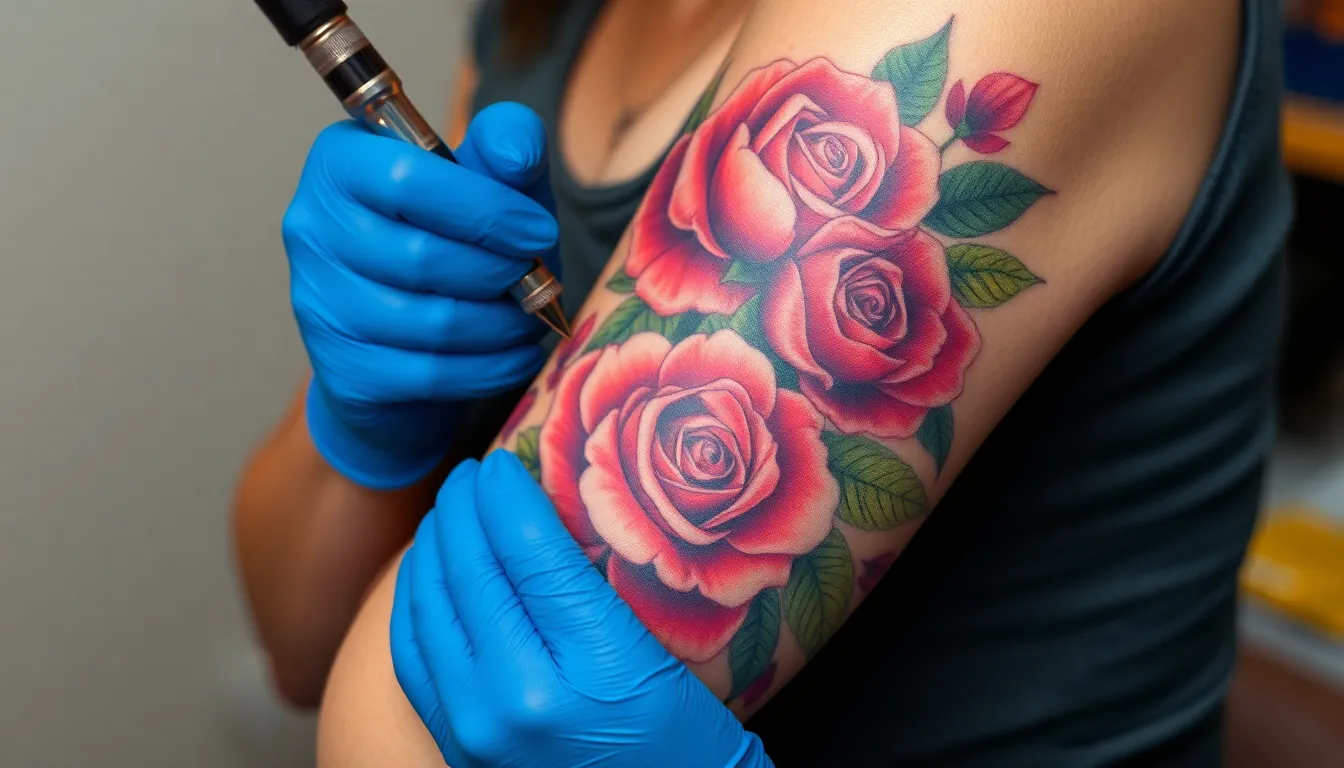
Understanding design categories helps us navigate the most effective options for transforming unwanted ink. Each category offers unique advantages for concealing existing tattoos while creating stunning new artwork.
Nature and Botanical Designs
Flowers lead our list of botanical answers, with roses and peonies serving as top choices for covering names or small tattoos. These designs work exceptionally well because their organic shapes and layered petals create natural shadows that mask underlying ink.
Trees and branches provide excellent coverage for larger areas by establishing natural, flowing compositions. We’ve seen artists use oak trees, cherry blossoms, and willow branches to create expansive designs that completely transform broad sections of skin.
Leaves and vines offer versatility through their ability to intertwine and create cohesive patterns. Artists often incorporate these elements to connect different parts of a design, ensuring seamless coverage while maintaining visual appeal.
Geometric Patterns and Mandala Styles
Geometric patterns use repeating elements to create visual confusion, making original tattoos nearly impossible to detect. These designs rely on strategic placement of shapes, lines, and patterns that overwhelm the eye and redirect attention from underlying artwork.
Mandala designs excel at covering almost any space due to their dense, symmetrical patterns and intricate details. We recommend these circular compositions for their ability to incorporate multiple layers of imagery while maintaining perfect balance and visual impact.
Animal and Wildlife Motifs
Fish designs, particularly koi fish, dominate Japanese traditional cover up work due to their flowing forms and bold colors. Artists frequently use these aquatic creatures to mask existing tattoos while creating culturally important artwork.
Birds like peacocks and owls provide excellent options for covering names or other unwanted designs through their elaborate plumage and wingspan. Peacock feathers especially offer rich textures and vibrant colors that effectively conceal underlying ink.
Underwater scenes create heavy shadows and complex textures that make original tattoos virtually invisible. These compositions allow artists to incorporate coral reefs, sea life, and water effects that naturally obscure previous work.
Abstract and Artistic Compositions
Abstract art allows maximum creative freedom through strategic use of colors, shapes, and textures that distract from original tattoos. Artists can experiment with brushstroke effects, color bleeding, and unconventional compositions to achieve complete coverage.
Silhouettes offer simple yet highly effective answers for small to medium sized tattoos through their bold, solid shapes. We’ve observed excellent results with mountain ranges, city skylines, and forest treelines that create dramatic contrast while completely masking unwanted ink.
Dark and Bold Cover Up Solutions
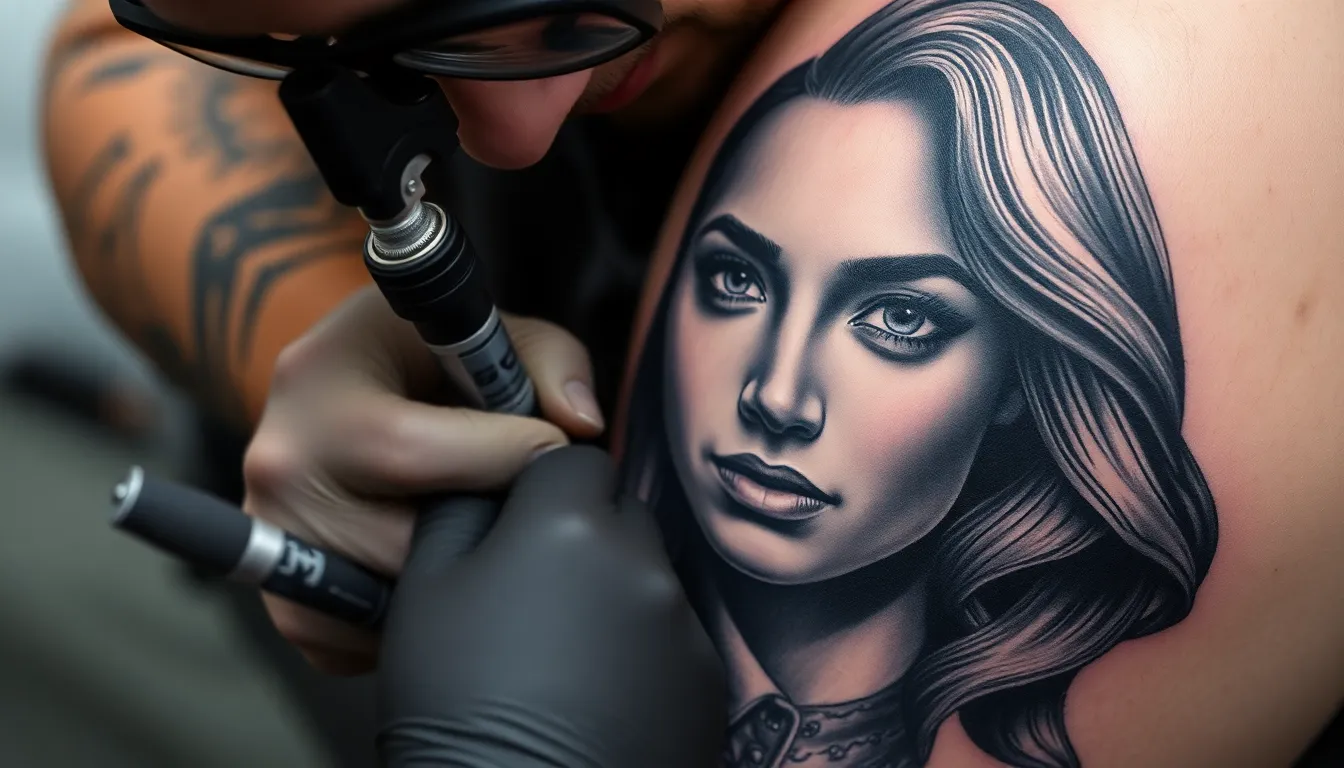
When traditional methods aren’t enough, dark and bold cover-up approaches offer the most effective concealment options. These techniques rely on solid black elements and high-contrast designs to completely mask existing tattoos.
Black and Grey Realistic Portraits
Realistic portraits excel at hiding unwanted tattoos through their sophisticated shading techniques. Artists use varying degrees of black and grey tones to create depth and dimension that naturally camouflages old ink beneath the surface. The strategic placement of shadows and highlights transforms problematic areas into essential parts of the portrait’s composition.
Detailed facial features provide excellent coverage opportunities since they require extensive shading work. Eyes, hair, and clothing elements offer dark areas perfect for concealing previous tattoos. We’ve seen countless successful transformations where old tribal pieces disappear completely within a portrait’s shadow work.
Celebrity portraits and family members remain popular choices for cover-up work. These meaningful images give clients emotional investment in their new tattoo while effectively hiding past mistakes. Artists can adjust facial angles and add background elements to accommodate the shape and size of existing tattoos.
Traditional American Style Designs
Bold outlines characteristic of traditional American tattoos create perfect borders for cover-up work. These thick black lines serve as natural barriers that prevent old tattoo colors from showing through. The style’s emphasis on solid color blocks makes it particularly effective for masking light-colored or faded existing tattoos.
Classic motifs like anchors, roses, and eagles offer versatile options for different body placements. Roses work exceptionally well for covering small to medium tattoos with their layered petal structure. Eagles provide large wing spans that can cover broader areas of unwanted ink.
Vibrant color schemes in traditional designs draw attention away from any residual visibility of old tattoos. Red roses, blue anchors, and yellow banners create visual focal points that redirect the eye. These bright colors effectively neutralize duller tones from previous tattoo work.
Japanese Traditional Motifs
Koi fish designs incorporate flowing water elements that naturally disguise irregular shapes from existing tattoos. The curved body of the koi and surrounding wave patterns create organic coverage that adapts to various tattoo sizes. Scale details and fin work provide additional texture to mask underlying ink completely.
Cherry blossom branches offer delicate yet effective coverage through their spreading pattern. Petals and leaves create natural camouflage while maintaining artistic beauty. The organic flow of branches allows artists to work around existing tattoo shapes seamlessly.
Wave patterns from traditional Japanese art excel at covering linear tattoos like text or geometric designs. These flowing elements create visual movement that distracts from any remaining traces of old ink. Combined with foam details and splash effects, wave motifs provide comprehensive coverage options.
Tribal and Polynesian Patterns
Geometric shapes in tribal designs create visual confusion that effectively hides underlying tattoos. Thick black lines and solid fill areas provide maximum coverage density. The angular nature of these patterns works particularly well for covering script tattoos or small symbols.
Polynesian motifs incorporate meaningful symbols while providing excellent coverage capabilities. Turtles, sharks, and wave patterns offer both cultural significance and practical concealment benefits. These designs can be scaled to accommodate various tattoo sizes while maintaining their visual impact.
Intricate line work in tribal patterns creates layered coverage that completely obscures old tattoos. The repetitive nature of these designs allows artists to build density gradually until complete coverage is achieved. Bold contrasts between black ink and skin tone ensure maximum concealment effectiveness.
Creative Transformation Techniques
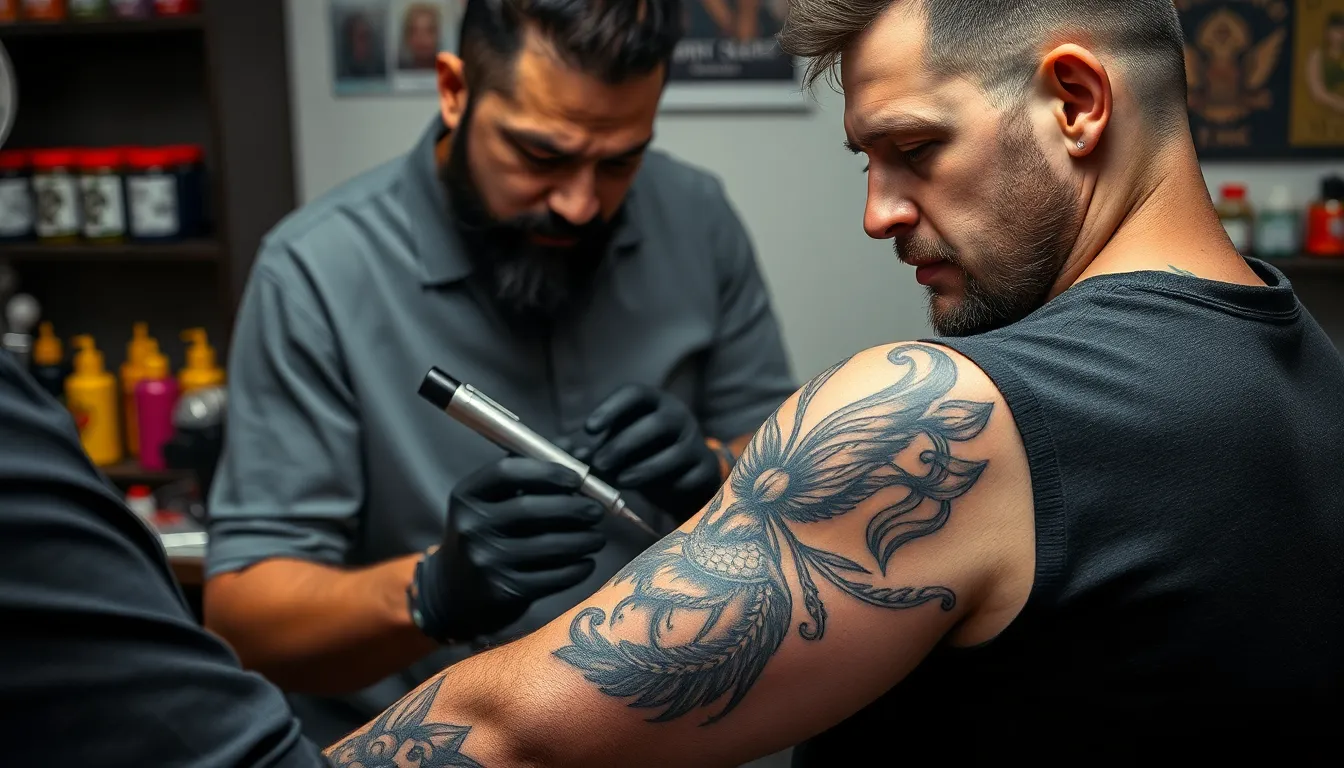
Smart tattoo artists understand that successful cover-ups don’t always require complete obliteration of the original design. We’ve discovered that strategic transformation approaches can turn your unwanted ink into stunning new artwork.
Incorporating Original Elements
Reinvention transforms parts of your existing tattoo into integral components of a fresh design rather than hiding them completely. Artists can skillfully integrate exact shapes, lines, or patterns from your old tattoo to create cohesive new artwork that feels intentional and unified.
Adding complementary elements works exceptionally well when you incorporate nature-inspired designs like leaves, vines, or flowing water around existing imagery. We’ve seen countless successful transformations where artists blend botanical elements with original tattoo components to create seamless, organic compositions that look like they were always meant to be together.
Expanding and Extending Existing Tattoos
Blast over techniques involve adding bold black lines and illustrative elements that create entirely new visual impact. This approach works particularly well when your original tattoo features light or faded colors that can serve as subtle background texture for dramatic new designs.
Strategic expansion allows artists to extend your existing tattoo outward, incorporating the old design as a central focal point within a larger composition. We recommend this method when you want to preserve certain elements while dramatically changing the overall aesthetic and scale of your body art.
Using Negative Space Effectively
Contrast creation utilizes blank areas strategically to minimize visibility of unwanted tattoo elements while drawing attention to new design features. Artists can leave exact sections untouched to create visual breaks that naturally guide the eye away from problematic areas.
Focal point placement involves adding visually captivating elements or intricate patterns in key locations to distract from the original design. We’ve observed that placing detailed mandala work, realistic portraits, or geometric patterns in strategic spots can completely shift the viewer’s attention to the new artwork.
Blending Old and New Designs
Color blending techniques use gradients and smooth color transitions to merge your existing tattoo with fresh design elements, creating seamless visual flow. Artists employ complementary color theory to neutralize unwanted hues while building harmonious new color palettes that feel cohesive and intentional.
Geometric pattern integration incorporates shapes, lines, and mathematical designs to visually break up existing tattoo elements, making them less noticeable within the overall composition. We’ve found that sacred geometry, tribal patterns, and modern geometric designs can effectively fragment old imagery while creating striking new visual narratives.
Specialty Cover Up Approaches

We’ve explored foundational techniques for transforming unwanted tattoos, but certain situations require specialized approaches that address unique challenges. These targeted methods ensure successful concealment while creating stunning new artwork.
Name and Text Cover Ups
Integrating additional text transforms awkward lettering into meaningful phrases or quotes. We recommend expanding single names into song lyrics, poetry, or personal mantras that hold deeper significance. Flowing script fonts naturally mask blocky original lettering, while decorative flourishes add visual interest.
Floral and ornate frames effectively conceal names by surrounding them with intricate botanical designs. Roses, peonies, and vine work create natural borders that draw attention away from unwanted text. Ornamental scrollwork and filigree patterns provide elegant answers for smaller name tattoos, transforming them into decorative art pieces.
Small Tattoo Transformation Ideas
Incorporating natural elements allows us to blend existing small tattoos seamlessly into larger organic designs. Adding leaves, vines, or flower petals around the original tattoo creates a cohesive garden scene. Tree branches naturally extend from existing elements, while water ripples can transform simple shapes into pond reflections.
Using negative space strategically creates contrast that helps conceal the old tattoo within the new design. We leave certain areas blank to form silhouettes or create breathing room around dense patterns. This technique works particularly well with geometric designs where empty spaces become integral parts of the overall composition.
Covering Scars and Imperfections
Dark colors and strategic shading effectively mask scars by creating depth and dimension over irregular skin texture. We employ deep blues, purples, and blacks to minimize the appearance of raised or indented areas. Heavy shading techniques camouflage texture variations while building rich, dramatic artwork.
Intricate patterns distract attention from skin imperfections through visual complexity. Mandala designs work exceptionally well because their repetitive elements create optical flow across scarred areas. Tribal patterns and Celtic knotwork provide dense coverage while maintaining cultural authenticity and artistic integrity.
Cultural and Religious Symbol Updates
Incorporating symbolic elements allows us to respectfully update outdated religious or cultural tattoos. We blend existing symbols with complementary imagery from the same tradition, creating more comprehensive representations. Adding prayer beads, sacred geometry, or traditional motifs enriches the original design while maintaining cultural sensitivity.
Blending with nature combines cultural symbols with organic elements to create harmonious, respectful artwork. Trees of life naturally incorporate existing religious symbols, while animals sacred to exact cultures can embrace or surround the original tattoo. This approach honors the initial meaning while creating fresh, beautiful interpretations.
Planning Your Cover Up Timeline
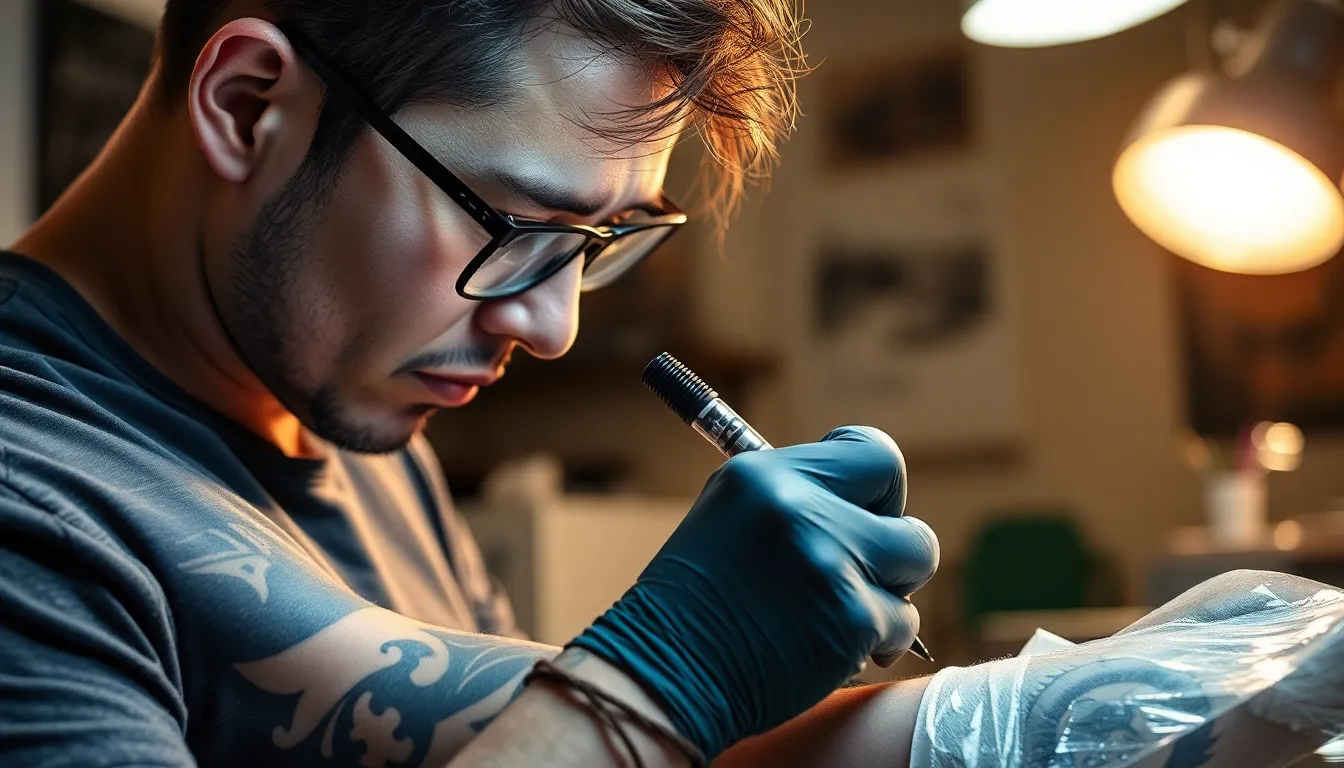
Successful cover up tattoos require careful timing and strategic planning to achieve optimal results. We’ll break down the essential timeline considerations to help you navigate this multi-step process effectively.
Healing Time Between Sessions
Proper healing between cover up sessions typically takes 2 to 4 weeks for the outer layer of skin to fully recover. Each session places additional stress on your skin since the tattoo artist works over existing ink, which can extend the healing process compared to fresh tattoos on unmarked skin.
During this healing period, your skin needs time to regenerate and settle before the next application of ink. We recommend allowing your tattoo artist to assess the healing progress at each appointment, as individual healing rates can vary based on factors like age, skin type, and aftercare practices.
Multiple Session Planning
Most cover up tattoos require multiple sessions spaced 2 to 4 weeks apart to achieve complete coverage and desired results. Complex designs or larger original tattoos often need three to five sessions, depending on the darkness and size of the existing artwork.
Your tattoo artist will create a session plan during the initial consultation, outlining how many appointments you’ll likely need. Each session builds upon the previous work, gradually layering new ink to effectively mask the underlying tattoo while developing the new design.
Session scheduling should account for your personal commitments and healing capacity. We suggest booking multiple appointments in advance to secure your preferred time slots and maintain consistent progress on your cover up project.
Touch-Up and Maintenance Schedule
Touch up sessions may be necessary 4 to 6 weeks after your final cover up session to ensure complete coverage and color vibrancy. These minor adjustments address any areas where the original tattoo might still show through or where color intensity needs enhancement.
Your artist will evaluate the healed tattoo and recommend exact touch ups based on how well the cover up settled into your skin. Most cover up tattoos benefit from at least one touch up session to achieve the polished, professional appearance you’re seeking.
Regular maintenance appointments every 2 to 3 years can help preserve your cover up’s appearance and address any fading that occurs over time. These sessions keep your new artwork looking fresh and ensure the original tattoo remains completely concealed.
Long-Term Care Considerations
Sun protection becomes crucial for maintaining your cover up tattoo’s effectiveness and preventing the underlying artwork from becoming visible again. We recommend using SPF 30 or higher sunscreen daily on your tattooed area to prevent fading and skin damage.
Consistent skin hydration helps preserve both the new tattoo’s appearance and the cover up’s concealment properties. Apply fragrance free moisturizer regularly to keep your skin healthy and maintain the tattoo’s vibrancy.
Annual assessments with your tattoo artist can help identify any areas where the original tattoo might start showing through due to natural fading. Early intervention with minor touch ups prevents major visibility issues and keeps your cover up looking seamless for years to come.
Cost Factors and Budgeting Tips
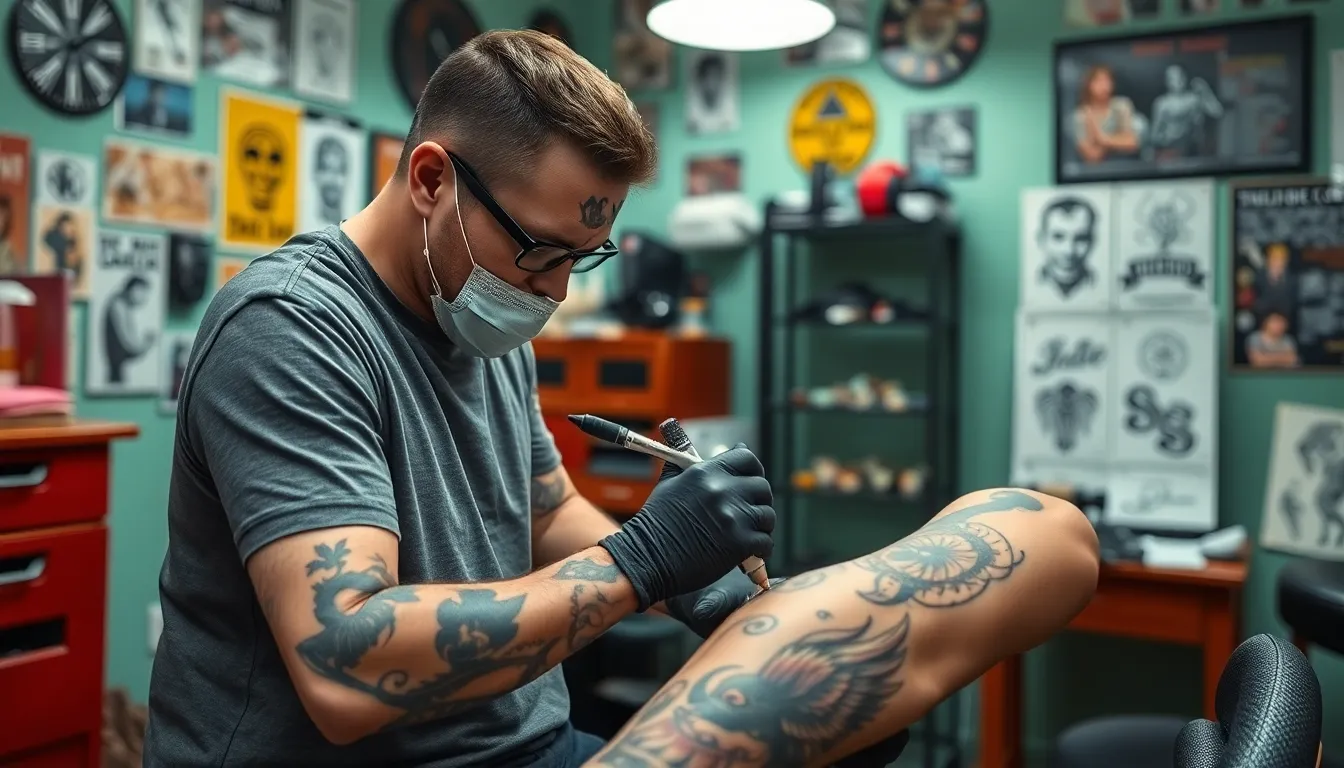
Planning your cover up tattoo budget requires understanding several key financial considerations that go beyond traditional tattoo pricing. We’ll break down these essential cost factors to help you make informed decisions about your investment.
Understanding Cover Up Pricing Structure
Cover up tattoos generally cost more than new tattoos due to the additional work required to cover existing ink. Artists typically charge by the hour, with rates ranging from $50 to $300+ per hour depending on their experience level.
Size and complexity significantly impact your final cost since larger or more intricate cover up designs require more time and ink to complete effectively. Location also plays a crucial role in pricing, as tattoo shops in major cities or upscale areas tend to have higher rates than smaller towns.
We’ve found that cover up work demands specialized skills that justify the premium pricing, making it essential to budget for these additional costs upfront.
Comparing Artist Rates and Quality
Artist experience levels directly correlate with hourly rates, creating a clear pricing hierarchy in the tattoo industry:
| Artist Level | Hourly Rate Range |
|---|---|
| Beginner | $50-$100 |
| Intermediate | $100-$200 |
| Experienced | $200-$350 |
| Expert/Celebrity | $350-$1000+ |
Balancing cost with quality becomes crucial when selecting your cover up artist. More experienced artists charge higher rates due to their skill and reputation, but their expertise often results in superior coverage and artistry.
We recommend investing in an experienced artist rather than choosing based solely on price, as cover up tattoos require advanced technical skills to achieve seamless results.
Planning for Multiple Sessions
Larger or complex cover up tattoos may require multiple sessions to complete, increasing both your overall cost and time commitment. Most cover up projects need three to five appointments for complete coverage, with each session building upon the previous work.
Session spacing typically requires 2 to 4 weeks between appointments to allow proper healing. This extended timeline means budgeting for additional travel costs if your chosen artist isn’t local.
We suggest discussing the expected number of sessions during your consultation to create an accurate budget that accounts for the full project scope.
Aftercare Product Investments
Quality aftercare products ensure proper healing and minimize potential complications that could affect your cover up’s appearance. These essential supplies include specialized ointments, gentle cleansers, and moisturizers designed for tattooed skin.
Investment in premium aftercare products typically ranges from $30 to $80, depending on the size of your tattoo and healing duration. Sun protection products become particularly important for maintaining your cover up’s appearance over time.
We recommend including aftercare costs in your initial budget to ensure you have everything needed for optimal healing and long term tattoo preservation.
Conclusion
Cover-up tattoos offer an incredible opportunity to transform regrettable ink into meaningful artwork that truly represents who you are today. With the right artist and proper planning your old tattoo can become the foundation for something even more beautiful than you originally imagined.
Remember that successful cover-ups require patience investment and realistic expectations. The process might take multiple sessions and cost more than a fresh tattoo but the results are worth every penny when you can finally look at your skin with pride again.
Whether you choose bold florals intricate mandalas or striking geometric patterns the key is working with an experienced cover-up specialist who understands both the technical challenges and creative possibilities. Your skin tells your story – make sure it’s one you’re excited to share.
Frequently Asked Questions
What makes a tattoo design effective for cover-ups?
Bold imagery with solid black areas and high contrast elements work best for covering existing tattoos. Organic shapes like flowers and geometric patterns create visual confusion that helps mask underlying ink. The new design typically needs to be 2-3 times larger than the original tattoo for complete coverage.
How much do cover-up tattoos cost compared to new tattoos?
Cover-up tattoos generally cost 20-40% more than fresh tattoos due to increased complexity and size requirements. Pricing varies based on artist experience, design intricacy, and the number of sessions needed. Budget for potential hidden costs and discuss payment options with your chosen artist.
What types of designs work best for covering unwanted tattoos?
Nature and botanical designs like flowers, trees, and vines are highly effective due to their organic shapes. Geometric patterns and mandalas create visual confusion, while animal motifs offer vibrant options. Dark, bold designs with solid black elements provide the most reliable coverage.
How do I choose the right artist for a cover-up tattoo?
Look for artists with strong portfolios specifically showcasing cover-up work and positive client testimonials. Schedule thorough consultations to discuss design planning and realistic expectations. Experience with cover-ups is crucial since this specialized work requires different techniques than fresh tattoos.
Can darker colors effectively cover lighter tattoo inks?
Yes, darker colors are more effective at covering lighter inks. Color theory plays a crucial role – complementary colors can neutralize unwanted hues from the original tattoo. However, very dark or black original tattoos may require multiple sessions or specialized techniques for effective coverage.
How many sessions are typically needed for cover-up tattoos?
Most cover-up tattoos require multiple sessions, with 2-4 weeks between appointments for proper healing. The number of sessions depends on the original tattoo’s size, darkness, and the complexity of the new design. Your artist will provide a realistic timeline during consultation.
What creative techniques can transform existing tattoos?
Artists can incorporate original elements into new designs, expand existing tattoos, and use negative space effectively. Blending old and new designs through color transitions and geometric patterns creates cohesive artwork while minimizing visibility of unwanted elements.
Are there special considerations for covering text tattoos?
Text tattoos can be transformed by integrating additional lettering to create meaningful phrases or quotes. Floral and ornate frames work well to conceal names. The key is working with an experienced artist who can creatively incorporate existing text into a larger, cohesive design.
